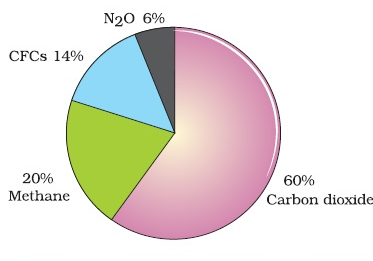12th Grade > Biology
ENVIRONMENTAL ISSUES MCQs
Total Questions : 38
| Page 2 of 4 pages
Answer: Option A. -> Acid rain
:
A
The Taj Mahalis situated in Agra. The air in this place contains high levels of sulphur and nitrogen oxides. This is due to the large number of power plants and industries set up around this area. These have been a major cause for acid rain, which has reacted with the marble (calcium carbonate) the Taj Mahal is made of. This has resulted in a gradual damage to this wonderful structure, which even today, is a major spot attracting tourists from all around the world.
:
A
The Taj Mahalis situated in Agra. The air in this place contains high levels of sulphur and nitrogen oxides. This is due to the large number of power plants and industries set up around this area. These have been a major cause for acid rain, which has reacted with the marble (calcium carbonate) the Taj Mahal is made of. This has resulted in a gradual damage to this wonderful structure, which even today, is a major spot attracting tourists from all around the world.
Answer: Option A. -> Both A and R are true and R explains A
:
A
Green Revolution involves increased deployment of technologies including the use of pesticides, herbicides, fertilisers as well as new breeds of high-yielding crops to greatly increase global food production. These fertilisers and pesticides used in large scale, have however, caused certain toxic effects to the environment.
1. Synthetic fertilisers contain toxic impurities like cadmium, lead, arsenic and uranium. These elements, when released into soil, lead to pollution of underwater reservoirs by leaching through the soil.
2. Pesticides like endosulfan pollute the air inhaled by humans and animals.
:
A
Green Revolution involves increased deployment of technologies including the use of pesticides, herbicides, fertilisers as well as new breeds of high-yielding crops to greatly increase global food production. These fertilisers and pesticides used in large scale, have however, caused certain toxic effects to the environment.
1. Synthetic fertilisers contain toxic impurities like cadmium, lead, arsenic and uranium. These elements, when released into soil, lead to pollution of underwater reservoirs by leaching through the soil.
2. Pesticides like endosulfan pollute the air inhaled by humans and animals.
Answer: Option A. -> I and III
:
A
Non-degradable pollutants either do not degrade,ormay degrade extremely slowly in the natural environment.e.g., DDT, BHC. Anthropogenic pollutants are man-made pollutants such as sewage, pesticides, fertilisers, etc. Primary air pollutants are those which pollute the air directly as soon as they get released from the source. Carbon monoxide is an example. In traffic congested cities, the brown air effect is caused due to oxides of nitrogen.
:
A
Non-degradable pollutants either do not degrade,ormay degrade extremely slowly in the natural environment.e.g., DDT, BHC. Anthropogenic pollutants are man-made pollutants such as sewage, pesticides, fertilisers, etc. Primary air pollutants are those which pollute the air directly as soon as they get released from the source. Carbon monoxide is an example. In traffic congested cities, the brown air effect is caused due to oxides of nitrogen.
Answer: Option D. -> Many of the birds' eggs laid, did not hatch
:
D
Biomagnification refers to an increase in concentration of atoxicant at successively higher trophic levels. This happens because a toxic substance accumulated by an organism cannot be metabolised or excretedand is thus, passed on in the food chain. DDT biomagnification occurs in aquatic food chains. If the concentration of DDT in water for instance, is 0.003 ppb (ppb = parts per billion) in water, that ultimately reaches25 ppm (ppm = parts per million) in fish-eating birds, through biomagnification. High concentration of DDT disturbs calcium metabolism in birds which causes thinning of egg shells and their premature breaking.
:
D
Biomagnification refers to an increase in concentration of atoxicant at successively higher trophic levels. This happens because a toxic substance accumulated by an organism cannot be metabolised or excretedand is thus, passed on in the food chain. DDT biomagnification occurs in aquatic food chains. If the concentration of DDT in water for instance, is 0.003 ppb (ppb = parts per billion) in water, that ultimately reaches25 ppm (ppm = parts per million) in fish-eating birds, through biomagnification. High concentration of DDT disturbs calcium metabolism in birds which causes thinning of egg shells and their premature breaking.
Answer: Option D. -> All of these
:
D
Although there are natural sources of sulphur dioxide (accounting for 35-65% of the total sulphur dioxide emissions) such as volcanoes, most anthropogenic sulphur dioxide is produced by burning fuels containing sulphur or by roasting metal sulphide ores. Thermal power plants burning high-sulphur coal or heating oil are generally the main sources of sulphur dioxide emissions worldwide, followed by industrial boilers and nonferrous metal smelters. Emissions from domestic coal burning and from vehicles can also contribute to high concentrations of sulphur dioxide.
:
D
Although there are natural sources of sulphur dioxide (accounting for 35-65% of the total sulphur dioxide emissions) such as volcanoes, most anthropogenic sulphur dioxide is produced by burning fuels containing sulphur or by roasting metal sulphide ores. Thermal power plants burning high-sulphur coal or heating oil are generally the main sources of sulphur dioxide emissions worldwide, followed by industrial boilers and nonferrous metal smelters. Emissions from domestic coal burning and from vehicles can also contribute to high concentrations of sulphur dioxide.
Answer: Option C. -> Release of SO2 and NO from burning fossil fuels
:
C
Acid rain is caused by a chemical reaction that begins when compounds likesulphur dioxideandnitrogen oxidesare released into theair. These substances can rise very high into the atmosphere, where they mix and react with water,oxygen and other chemicals to form more acidic pollutants to precipitate down as acid rain.
:
C
Acid rain is caused by a chemical reaction that begins when compounds likesulphur dioxideandnitrogen oxidesare released into theair. These substances can rise very high into the atmosphere, where they mix and react with water,oxygen and other chemicals to form more acidic pollutants to precipitate down as acid rain.
Answer: Option B. -> Radioactive substances
:
B
Solid wastes that we generate in the environment can be categorised into three groups:
1. Biodegradable wastes are those wastes that are capable of being decomposed in a reasonable amount of time by bacteria or other living organisms and thus, do not cause pollution. Examples include human and animal waste, biofertilisers, kitchen waste etc.
2. Recyclable wastes are those that can be converted to reusable material. Glass, cardboard boxes, paper products, etc. are examples.
3. Non-biodegradable wastes thosethat can not be broken down into their base compounds by microorganisms, air, moisture or soil in a reasonable amount of time. Radioactive elements, plastic, metal scraps etc. are non-biodegradable.
:
B
Solid wastes that we generate in the environment can be categorised into three groups:
1. Biodegradable wastes are those wastes that are capable of being decomposed in a reasonable amount of time by bacteria or other living organisms and thus, do not cause pollution. Examples include human and animal waste, biofertilisers, kitchen waste etc.
2. Recyclable wastes are those that can be converted to reusable material. Glass, cardboard boxes, paper products, etc. are examples.
3. Non-biodegradable wastes thosethat can not be broken down into their base compounds by microorganisms, air, moisture or soil in a reasonable amount of time. Radioactive elements, plastic, metal scraps etc. are non-biodegradable.
Answer: Option A. -> DDT is biodegradable and does not undergoes biomagnification
:
A
Biomagnification is theprocess bywhich toxicsubstanceswhich cannot be metabolised by the body, startbecoming more and more concentrated at successive trophic levels. DDT was once, used extensively as a pesticide and was sprayed on crops to kill insects. However, it has beennoticed that through run off from fields, DDT enters streams and lakes, and enters the food chain of aquatic plants and animals. Because DDT is non-biodegradable, it keeps accumulating attoxic levels in living bodies.
:
A
Biomagnification is theprocess bywhich toxicsubstanceswhich cannot be metabolised by the body, startbecoming more and more concentrated at successive trophic levels. DDT was once, used extensively as a pesticide and was sprayed on crops to kill insects. However, it has beennoticed that through run off from fields, DDT enters streams and lakes, and enters the food chain of aquatic plants and animals. Because DDT is non-biodegradable, it keeps accumulating attoxic levels in living bodies.
Answer: Option A. -> Ozone layer
:
A
Theozone layeris a naturallayerof gas in the upper atmosphere which protects humans and other living things from the harmful ultraviolet (UV) rays of the sun. Thisozone layerperforms the essential task of filtering out most of the sun's biologically harmful UV radiation.
:
A
Theozone layeris a naturallayerof gas in the upper atmosphere which protects humans and other living things from the harmful ultraviolet (UV) rays of the sun. Thisozone layerperforms the essential task of filtering out most of the sun's biologically harmful UV radiation.


















